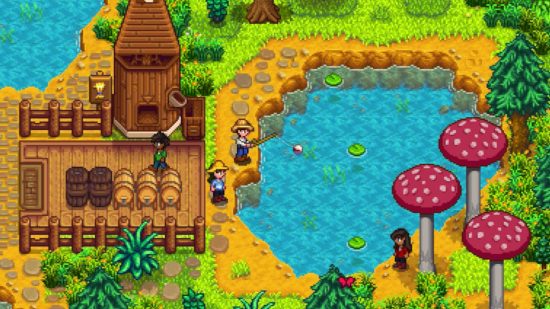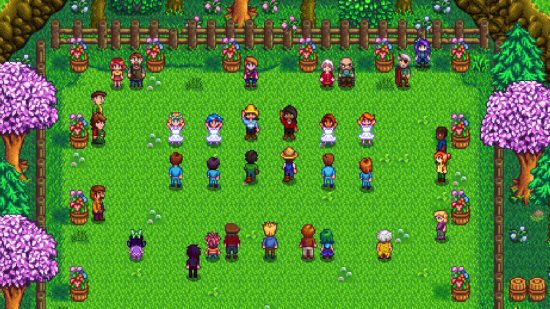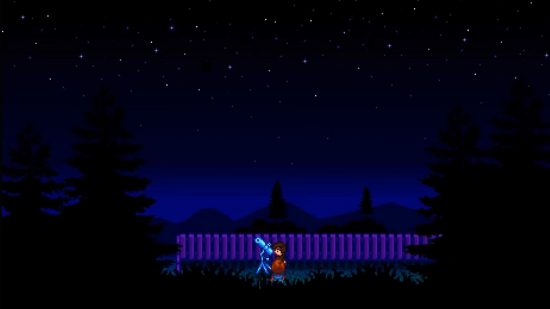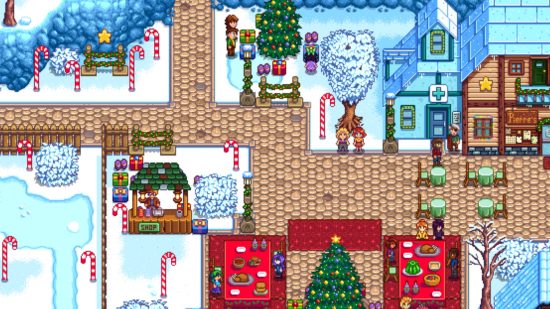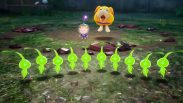Warning: this review touches on themes of substance abuse, grief, and mental health issues.
If I were to filibuster any event, I would do so by giving my argument for Stardew Valley as the best game of all time. You can disagree, and that’s perfectly fine, but be well aware that I have a baby-names-book-sized list of my own reasons. It’s iconic. It’s engaging. It’s, well, to me, it’s everything, but for the purposes of this retrospective Stardew Valley review, let’s start from the start.
Stardew Valley is the result of lone developer Eric Barone going under the name ConcernedApe. Barone’s key inspiration was the Story of Seasons series, with the developer looking to make his own game belonging to the perpetually vague ‘farm sim’ genre. So, in 2011 he started work on the game, with Chucklefish signing up to publish it in 2013, and the final product arriving on Steam on February 26, 2016. Now, it’s available on nearly all consoles, with over five years of content updates to expand Stardew Valley beyond the farm.
So, onto the game itself. Stardew Valley is first and foremost a farming simulator. The game opens with your grandpa on his deathbed, with the old man leaving you a gift to open on the day “your bright spirit will fade before a growing emptiness.” This day arrives before too long, with your character working in a cubicle at the Joja Corporation – this game’s Amazon equivalent corporate entity – finally snapping and opening up the letter. It is, of course, informing you of your inheritance of the farm.
You up sticks and head for the valley, only to find your very own farmhouse and piece of green earth. Here, you meet Mayor Lewis and Penny, the local carpenter, who give you the lay of the land. Most Stardew experiences start in the same way. You plant your complimentary turnip seeds, introduce yourself to the locals, and get your head around fishing, mining, foraging, and combat. Those four mechanics, plus farming, make up the core of this game, and the idea is to reach level ten for each.

Once things are up and running on the farm, you encounter the main goal of Stardew Valley, restoring the community center. When you arrive in town, the building is in ruins and seemingly beyond repair, sitting across the river from the Joja Mart. At this point, the game offers you two options. You can either save up to hand over a massive amount of cash to the Joja corporate stooge, repairing some of Pelican Town’s issues, such as a broken mine cart system and no bus service, or you can slowly fulfill the community center bundles to restore to the community center and Pelican Town pumping again.
Let’s be frank. If you take the Jojo Mart deal, I don’t like you, I don’t trust you, and we can’t be friends. The game doesn’t like you much for making this decision either, as it cuts a fair bit of content if you go down that road. The only sensible option is to complete the community center bundles, as complex as that might feel at first, allowing the spirits of the forest – or Junimos, as they’re known in-game – to restore the building to its former glory.
Still, one of the better things about Stardew Valley is that it doesn’t really care what you do. There are things to push you in the right direction if you need direction, but otherwise, once the first couple of months are out of the way, it’s all on you. In my first ever play-through, I didn’t even bother with the community center – don’t worry, I didn’t bother with Joja Mart either – but I just had a nice little time. I farmed three seasons out of the year and spent winter down in the mines. For nearly 100 hours I carried on like that, happy as a pig in muck, content to just continue.
We’ve touched on farming, but all five of Stardew Valley’s key mechanics hit the mark. Foraging is a great way of getting your head around the map in the early game. Combat gives you a reprieve from the humdrum of farm life, while mining offers resources and a treasure-collecting element. There is, however, also fishing.
Fishing, in my experience, is the most controversial element of Stardew Valley. It is one of the few mechanics in this game that can be properly frustrating but in that even more annoying way where you know it’s kind of your own fault. You just have to look at your little sixteen-bit avatar and tell that sucker to git gud. There is one thing all these concepts have in common, though. They all get better. Over your play time, each opens up with new monsters to beat, fish to catch, and rocks to smash. Your to-do list grows exponentially with each day on the farm, and that isn’t a bad thing.
Of course, no Stardew Valley review is worth its salt without talking about the cast of characters who call Pelican Town home. It’s clear that each character belongs to a stereotype, from Alex the jock to Leah the nature-loving hippie, but the game contorts these caricatures to find something deeper underneath. Everyone has problems, and you’re not there to solve them alone but together with the community for the betterment of those who live in the valley.
The writing doesn’t coddle you, though. Despite Stardew appearing on every ‘cozy games’ list in existence, things can get uncomfortable at times. You have to deal with Pam and Shane’s alcoholism, Clint’s longing, and Alex’s mourning, to name just a few, but this is always done with care and consideration. Each situation is given the levity it deserves, and it makes you feel as if you are truly part of the community, and for some, it might even offer a form of emotional catharsis in how openly the game deals with these issues.
Not content with developing the whole thing himself, Barone is also responsible for the Stardew Valley soundtrack, and oh man does that thing bop. With tracks for every season, the score for this game is famous for its catch melody lines, rivaling fellow indie darlings Undertale in terms of in-game music that flawlessly lends itself to the core concept. Across the board, the Stardew Valley soundtrack ranges from relaxing to riveting, but it’s never boring, and it never feels out of place.
For me, though, the most incredible part of Stardew Valley is the game loop. With this being a seven-year-old game, I can say with experience that as someone who’s had some pretty tough times with mental health, this game has put a stop to that countless times. How? Forcing me to think of something else, that’s how.
As soon as the main menu melody chimes in, you’re whisked away to Pelican Town, where there’s so much to do that you almost lose every connection with the outside world. An in-game day is twenty minutes, giving you twenty minutes outside of the anxieties and troubles of your day-to-day life, and each day bleeds into each other in a way that makes it almost too easy to lose hours on end. What I’m trying to say is that in the next edition of Collin’s dictionary, the words ‘Stardew Valley’ alone are enough of a definition for the term ‘engaging’.
A cataclysmic end of a relationship and my dog dying is what Stardew got me through. For those periods of intense grief, Stardew delivered me somewhere else, and for that, I’ll always be grateful. It sounds silly, but just managing what you want to do on a specific day against the twenty-minute clock is enough to keep you occupied for years of in-game time, losing yourself to delving deeper into the mines, befriending the people of Pelican town, and, of course, farming.
Simply put, I’ve had a relationship with Stardew Valley unlike any other game. It just gets me. All these years later, in a much happier place, Stardew is the thing that helped me cement a relationship with the person I want to spend the rest of my life with. It did that not only by eventually offering local co-op – though foraging for my girlfriend certainly keeps me in her good books – but through teaching me a little bit about what life is, and, more importantly, what life can be if you interact, engage, and give people gifts that say ‘hey, I know you” when the recipient opens them. That last bit is extra important.
Thanks to annual content updates since 2016, the version of Stardew Valley available now is even more packed with things to do than it was on release. Now, once you’re done with the community center, you can visit the Witch’s Swamp, take a trip out to Ginger Island, or even turn your children into doves. Yes, that last one is a little dark, but it speaks to the endless ways to play Stardew Valley. Sick of your kids? Turn them into birds. Bored of your spouse? Wipe their memory. Then, you can feel a little better about it all by kicking back on the beaches of Ginger Island with a couple of bananas. It’s all possible.
There’s also something about Stardew Valley that coincides with a change in political sensibilities of the generation of us who have grown into adults between 2015 and now. Essentially, Stardew Valley is the archetypal anticapitalist fantasy. You leave your cubicle job, take up farming, and eventually, stick it to the man by running Joja out of town. There is an undiluted escapism there, something that captures the mood of those playing it. Saving the princess is your grandad’s trope, dissolving corporate structures is the hot new thing.
It’s not just these anti-capitalist undertones that ring true with the generation of gamers emerging between 2015 and now, but the sincerity too. Stardew Valley wears its heart on its sleeve. It’s not cynical, despite the option to further fund the Joja Mart, but it preaches the virtues of community and communication. It’s a big hippy commune in video game format, and you’re invited to sit in the bean bag for just as long as you want.
To this day, Stardew Valley is something of a beautiful enigma, a one-man show that somehow has evolved into the blueprint for the burgeoning ‘cozy games’ genre in less than a decade. If this review didn’t state it plainly enough, Eric Barone’s game is my favorite, it’s my desert island disk, my digitized comfort blanked, and the thing I pack ‘just in case’. It quite possibly saved my life. Sure, it might not save yours, but hey, farming is enough fun without pulling you in from an existential crisis. Just promise me this. If you do take the trip, always put the purple shorts in the potluck.
For our thoughts on the latest games, check out our Pikmin 1+2 review, Master Detective Archives: Rain Code review, and Sonic Origins Plus Switch review. Or, for more games with vegetables galore, see our picks for the best farm games on Switch and mobile.
Stardew Valley review
Stardew Valley is one of the most influential titles of the 21st century, providing a blueprint for a reimagined genre and endless hours of playability. Simply put, this game is a masterpiece and is set to go down as one of the greatest of all time.
